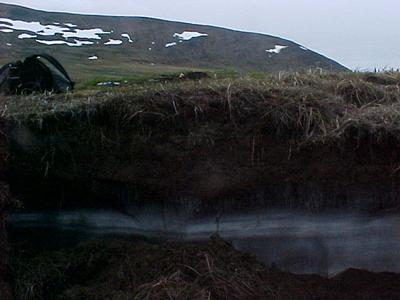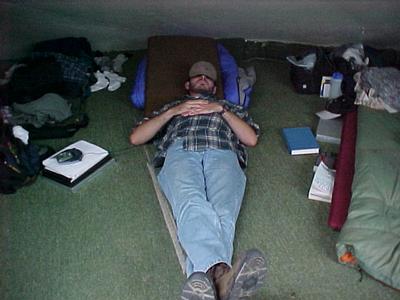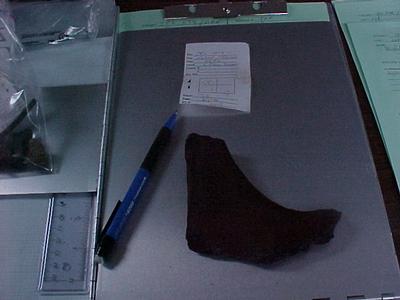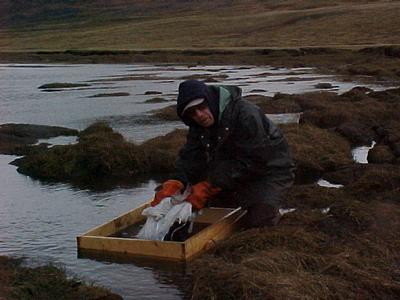
|
|
2 July, 2001
Wagaa Greetings (Yupik and Cu'pik)
We started off today by carrying the bags of fill from last year to the
inlet to be screened. I worked with Jon screening. You can see how thick
the permafrost is when we were done on the embankment. Veco is the company
through TEA that helped outfit me for this expedition. I thank them for
the rain pants, rainjacket, and boots. These three arcticles of wear are my
best friends (along with my trowel T3, of course). Standing in Arctic
water is cold (Brrrr.). We collected mostly wood, but we did find some
bones, flint, and a piece of ivory (walrus). In the afternoon, I worked on
the North trench mound (TEL 079), helping with the excavation. I had to
work around two walrus skulls. During excavations you have to trowel
around large posts, bones, etc., until you are almost finished with the
unit. For example, the walrus skulls then have to be measured in and drawn
in on graph paper for later analysis. Everything has to be mapped before
we take it up and continue excavating. Once an object is drawn in, simply
pick it up and continue. We also continued to bale out water from the
trench. We were able to finally take out the rest of the bags, through the
permafrost. We also had to re-measure the levels of the mound.
Bowhead whales: The Bowhead whale is vital to the people of Wales. These
whales have been hunted for centuries and are part of subsistence life for
the Inupiaq people of Wales.The Bowheads spend the winter in the Bring Sea
and Strait. They migrate into the Chuckchi and Beaufort seas during the
summer. A Bowhead is an enormous whale, with 1/3 of the whale being the
head. There may be as much as a ton of baleen. Baleen is the area (like
plates) that strains the food into the whale's mouth. The food is mainly
krill, a re shrimp like crustacean. Bowheads can have as much as 30 tons
of blubber. They can weigh as much as 50 tons. The blubber can be as thick
as six feet. This is how they are able to survive the temperatures of the
Arctic waters. The thick blubber also helps the hunters bring the whale to
shore. Hunters can see a Bowhead from a distance away because of the
spouts.
The Orca whale is the only known enemy of the Bowhead, except for humans.
The Bowhead will swim to waters that contain abundant ice. Orcas try to
avoid these waters because the ice damages their dorsal fins. People are
another story. The Bowhead whale is an integral part of Inupiaq history.
The whales became endangered when the Yankee whaling fleet came into
Arctic waters. Originally the Yankee whaling fleets fished off of the East
Coast of the U.S. and up into the Arctic region from Greenland. When they
depleted the whales, they looked to the Arctic Sea, from Alaska. Yankee
whaling used the blubber for oil for lamps. They did not use any other
part of the whale. The Arctic peoples, Inupiaq especially, used the entire
whale. They did waste. So, once again the Bowhead is an integral part of
Inupiaq history, a vital part of their subsistence living.

Here is what we have to deal with, perma frost

John is "chillin" after a hard day at the office

Here is one of my first finds, whale bone. It had to be tagged and recorded.

I am pictured here screening many bags of soil. They all needed to be filtered through.
Contact the TEA in the field at
.
If you cannot connect through your browser, copy the
TEA's e-mail address in the "To:" line of
your favorite e-mail package.
|
